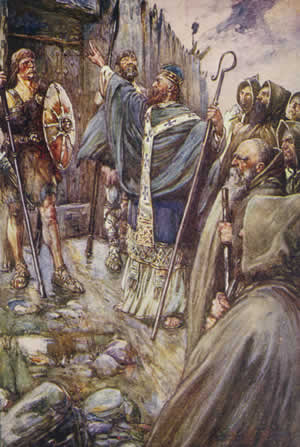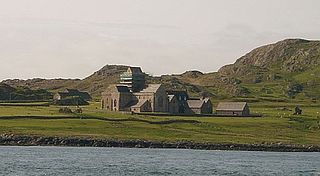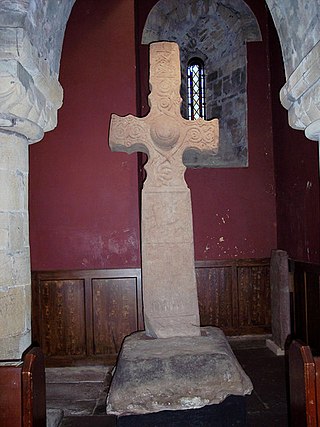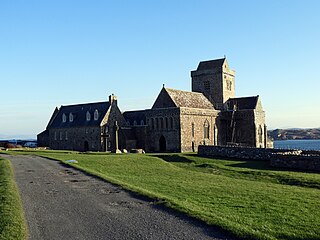
Columba or Colmcille was an Irish abbot and missionary evangelist credited with spreading Christianity in what is today Scotland at the start of the Hiberno-Scottish mission. He founded the important abbey on Iona, which became a dominant religious and political institution in the region for centuries. He is the patron saint of Derry. He was highly regarded by both the Gaels of Dál Riata and the Picts, and is remembered today as a Catholic saint and one of the Twelve Apostles of Ireland.

Iona is a small island in the Inner Hebrides, off the Ross of Mull on the western coast of Scotland. It is mainly known for Iona Abbey, though there are other buildings on the island. Iona Abbey was a centre of Gaelic monasticism for three centuries and is today known for its relative tranquility and natural environment. It is a tourist destination and a place for spiritual retreats. Its modern Scottish Gaelic name means "Iona of (Saint) Columba".

Causantín or Constantín mac Fergusa was king of the Picts, in modern Scotland, from 789 until 820. He was until the Victorian era sometimes counted as Constantine I of Scotland; the title is now generally given to Causantín mac Cináeda. He is credited with having founded the church at Dunkeld which later received relics of St Columba from Iona.
The House of Alpin, also known as the Alpínid dynasty, Clann Chináeda, and Clann Chinaeda meic Ailpín, was the kin-group which ruled in Pictland, possibly Dál Riata, and then the kingdom of Alba from the advent of Kenneth MacAlpin in the 840s until the death of Malcolm II in 1034.
Saint Ecgberht was an Anglo-Saxon monk of Northumbria. After studying at Lindisfarne and Rath Melsigi, he spent his life travelling among monasteries in northern Britain and around the Irish Sea. He was instrumental in the establishment of Wihtberht's mission to Frisia.

Clan MacInnes is a Scottish clan originally from the western highlands of Scotland. The origin of clan is Morvern and Ardgour, Argylshire, with its clan name coming into existence in the 13th century. The clan's chief and his heirs were assassinated in the 14th century meaning that the clan no longer has a clan chief. Clan MacInnes is not associated - in any way - with the Clan Innes which hails from Moray.

Cainnech of Aghaboe (515/16–600), also known as Saint Canice in Ireland, Saint Kenneth in Scotland, Saint Kenny and in Latin Sanctus Canicus, was an Irish abbot, monastic founder, priest and missionary during the early medieval period. Cainnech is one of the Twelve Apostles of Ireland and preached Christianity across Ireland and to the Picts in Scotland. He wrote a commentary on the Gospels, which for centuries was known as the Glas-Choinnigh or Kenneth's Lock or the Chain of Cainnech.

Iona Abbey is an abbey located on the island of Iona, just off the Isle of Mull on the West Coast of Scotland.

A coarb, from the Old Irish comarbae, meaning "heir" or "successor", was a distinctive office of the medieval church among the Gaels of Ireland and Scotland. In this period coarb appears interchangeable with "erenach", denoting the episcopally nominated lay guardian of a parish church and headman of the family in hereditary occupation of church lands. The coarb, however, often had charge of a church which had held comparatively high rank in pre‐Norman Ireland, or one still possessed of relatively extensive termon lands.

Donnchad mac Domnaill, called Donnchad Midi, was High King of Ireland. His father, Domnall Midi, had been the first Uí Néill High King from the south-central Clann Cholmáin based in modern County Westmeath and western County Meath, Ireland. The reigns of Domnall and his successor, Niall Frossach of the Cenél nEógain, had been relatively peaceful, but Donnchad's rule saw a return to a more expansionist policy directed against Leinster, traditional target of the Uí Néill, and also, for the first time, the great southern kingdom of Munster.

The Hiberno-Scottish mission was a series of expeditions in the 6th and 7th centuries by Gaelic missionaries originating from Ireland that spread Celtic Christianity in Scotland, Wales, England and Merovingian France. Celtic Christianity spread first within the Kingdom of Dál Riata, within Ireland and the western coast of Scotland. Since the 8th and 9th centuries, these early missions were called 'Celtic Christianity'.

Domhnall Mac Murchada, called Domnall Midi, was High King of Ireland. He belonged to the Clann Cholmáin branch of the Uí Néill. Clann Cholmáin's pre-eminence among the southern Uí Néill, which would last until the rise of Brian Bóruma and the end of the Uí Néill dominance in Ireland, dates from his lifetime.
Christianity in Medieval Scotland includes all aspects of Christianity in the modern borders of Scotland in the Middle Ages. Christianity was probably introduced to what is now Lowland Scotland by Roman soldiers stationed in the north of the province of Britannia. After the collapse of Roman authority in the fifth century, Christianity is presumed to have survived among the British enclaves in the south of what is now Scotland, but retreated as the pagan Anglo-Saxons advanced. Scotland was largely converted by Irish missions associated with figures such as St Columba, from the fifth to the seventh centuries. These missions founded monastic institutions and collegiate churches that served large areas. Scholars have identified a distinctive form of Celtic Christianity, in which abbots were more significant than bishops, attitudes to clerical celibacy were more relaxed and there were significant differences in practice with Roman Christianity, particularly the form of tonsure and the method of calculating Easter, although most of these issues had been resolved by the mid-seventh century. After the reconversion of Scandinavian Scotland in the tenth century, Christianity under papal authority was the dominant religion of the kingdom.
Congal Cáech was a king of the Cruthin of Dál nAraidi in the medieval Irish province of Ulaid, from around 626 to 637. He was king of Ulaid from 627–637 and, according to some sources, High King of Ireland.

Hinba is an island in Scotland of uncertain location that was the site of a small monastery associated with the Columban church on Iona. Although a number of details are known about the monastery and its early superiors, and various anecdotes dating from the time of Columba of a mystical nature have survived, modern scholars are divided as to its whereabouts. The source of information about the island is Adomnán's late 7th-century Vita Columbae.
Events from the 7th century in Ireland.
Events from the 6th century in Ireland.
Events from the 8th century in Ireland.
Baithéne mac Brénaind was an Irish monk, one of Saint Columba's followers who accompanied him to Scotland around 563, and was the first successor of the abbacy of Iona. The Annals of Tigernach record his birth in 534, and his death was likely between 596 and 598 according also to the Annals of Ulster. Irish genealogical records indicate him to be the "son of Brendan, son of Fergus, son of Conall Gulban, son of Niall Noígiallach", thus being a member of the Cenél Conaill branch of the Northern Uí Néill, as the abbots of Iona following the death of Columba often were.
The Cenél Conaill, or "kindred of Conall", are a branch of the Northern Uí Néill, who claim descent from Conall Gulban, son of Niall of the Nine Hostages, and allegedly the first Irish nobleman to convert to Christianity. Their kingdom was known as Tír Conaill, with their powerbase at Mag Ithe in the Finn valley, however they gradually expanded to cover what is now counties Donegal and Fermanagh. The Cenél Conaill clashed regularly with their kin the Cenél nEogain, eventually capturing the latters original power-base of Ailech in the Inishowen peninsula—in modern-day County Donegal—by the 12th century.









